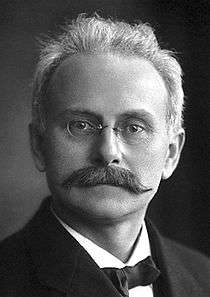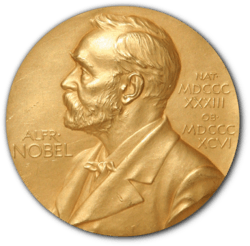Johannes Stark
| Johannes Stark | |
|---|---|
 | |
| Born |
15 April 1874 Schickenhof, German Empire |
| Died |
21 June 1957 (aged 83) Traunstein, West Germany |
| Nationality | Germany |
| Fields | Physics |
| Institutions |
University of Göttingen Technische Hochschule, Hannover Technische Hochschule, Aachen University of Greifswald University of Würzburg |
| Alma mater | University of Munich |
| Doctoral advisor | Eugen von Lommel |
| Known for | Stark effect |
| Notable awards |
Matteucci Medal (1915) Nobel Prize in Physics (1919) |
Johannes Stark (German pronunciation: [joˈhanəs ʃtaʁk], 15 April 1874 – 21 June 1957) was a German physicist and Physics Nobel Prize laureate, who was closely involved with the Deutsche Physik movement under the Nazi regime.
Biography
Early years
Born in Schickenhof, Kingdom of Bavaria (now Freihung), Stark was educated at the Bayreuth Gymnasium (secondary school) and later in Regensburg. His collegiate education began at the University of Munich, where he studied physics, mathematics, chemistry, and crystallography. His tenure at that college began in 1894; he graduated in 1897, with his doctoral dissertation titled Untersuchung über einige physikalische, vorzüglich optische Eigenschaften des Rußes (Investigation of some physical, in particular optical properties of soot).[1]
Career
Stark worked in various positions at the Physics Institute of his alma mater until 1900, when he became an unsalaried lecturer at the University of Göttingen. An extraordinary professor at Hanover by 1906, in 1908 he became professor at the RWTH Aachen University. He worked and researched at physics departments of several universities, including the University of Greifswald, until 1922. In 1919, he won the Nobel Prize in Physics for his "discovery of the Doppler effect in canal rays and the splitting of spectral lines in electric fields" (the latter is known as the Stark effect). From 1933 until his retirement in 1939, Stark was elected President of the Physikalisch-Technische Reichsanstalt, while also President of the Deutsche Forschungsgemeinschaft.
It was Stark who, as the editor of Jahrbuch der Radioaktivität und Elektronik, asked in 1907, then still rather unknown, Albert Einstein to write a review article on the principle of relativity. Stark seemed impressed by relativity and Einstein's earlier work when he quoted "the principle of relativity formulated by H. A. Lorentz and A. Einstein" and "Planck's relationship M0 = E0/c2" in his 1907 paper[2] in Physikalische Zeitschrift, where he used the equation e0 = m0c2 to calculate an "elementary quantum of energy", i.e. the amount of energy related to the mass of an electron at rest. While working on his article,[3] Einstein began a line of thought that would eventually lead to his generalized theory of relativity, which in turn became (after its confirmation) the start of Einstein's worldwide fame. This is heavily ironic, given Stark's later work as an anti-Einstein and anti-relativity propagandist in the Deutsche Physik movement.[4]
Stark published more than 300 papers, mainly regarding electricity and other such topics. He received various awards, including the Nobel Prize, the Baumgartner Prize of the Vienna Academy of Sciences (1910), the Vahlbruch Prize of the Göttingen Academy of Sciences (1914), and the Matteucci Medal of the Rome Academy. Probably his best known contribution to the field of physics is the Stark effect, which he discovered in 1913.
He married Luise Uepler, and they had five children. His hobbies were the cultivation of fruit trees and forestry. He worked in his private laboratory on his country estate in Upper Bavaria after the war. There he studied the deflection of light in an electric field.[5]
Affiliation with National Socialism
During the Nazi regime, Stark attempted to become the Führer of German physics through the Deutsche Physik ("German physics") movement (along with Philipp Lenard) against the "Jewish physics" of Albert Einstein and Werner Heisenberg (who was not Jewish). After Werner Heisenberg defended Albert Einstein's theory of relativity Stark wrote an angry article in the SS newspaper Das Schwarze Korps, calling Heisenberg a "White Jew".
On August 21, 1934 Stark wrote to physicist and fellow Nobel laureate Max von Laue to toe the party line or else. The letter was signed off with a "Heil Hitler."[6]
In his 1934 book Nationalsozialismus und Wissenschaft (English: "National Socialism and Science") Stark maintained that the priority of the scientist was to serve the nation—thus, the important fields of research were those that could help German arms production and industry. He attacked theoretical physics as "Jewish" and stressed that scientific positions in Nazi Germany should only be held by pure-blooded Germans.
In 1947, following the defeat of Germany in World War II, Stark was classified as a "Major Offender" and received a sentence of four years' imprisonment (later suspended) by a denazification court.
Publications
- Die Entladung der Elektricität von galvanisch glühender Kohle in verdünntes Gas. (Sonderabdruck aus 'Annalen der Physik und Chemie', Neue Folge, Band 68). Leipzig, 1899
- Der elektrische Strom zwischen galvanisch glühender Kohle und einem Metall durch verdünntes Gas. (Sonderabdruck aus 'Annalen der Physik und Chemie', Neue Folge, Band 68). Leipzig, 1899
- Aenderung der Leitfähigkeit von Gasen durch einen stetigen elektrischen Strom. (Sonderabdruck aus 'Annalen der Physik', 4. Folge, Band 2). Leipzig, 1900
- Ueber den Einfluss der Erhitzung auf das elektrische Leuchten eines verdünnten Gases. (Sonderabdruck aus 'Annalen der Physik', 4. Folge, Band 1). Leipzig, 1900
- Ueber elektrostatische Wirkungen bei der Entladung der Elektricität in verdünnten Gasen. (Sonderabdruck aus 'Annalen der Physik', 4. Folge, Band 1). Leipzig, 1900
- Kritische Bemerkungen zu der Mitteilung der Herren Austin und Starke über Kathodenstrahlreflexion. Sonderabdruck aus 'Verhandlungen der Deutschen Physikalischen Gesellschaft', Jahrgang 4, Nr. 8). Braunschweig, 1902
- Prinzipien der Atomdynamik. 1. Teil. Die elektrischen Quanten., 1910
- Schwierigkeiten für die Lichtquantenhypothese im Falle der Emission von Serienlinien. (Sonderabdruck aus 'Verhandlungen der Deutschen Physikalischen Gesellschaft', Jg. XVI, Nr 6). Braunschweig, 1914
- Bemerkung zum Bogen – und Funkenspektrum des Heliums. (Sonderabdruck aus 'Verhandlungen der Deutschen Physikalischen Gesellschaft.', Jg. XVI, Nr. 10). Braunschweig, 1914
- Folgerungen aus einer Valenzhypothese. III. Natürliche Drehung der Schwingungsebene des Lichtes. (Sonderabdruck aus `Jahrbuch der Radioaktivität und Elektronik', Heft 2, Mai 1914), Leipzig, 1914
- Methode zur gleichzeitigen Zerlegung einer Linie durch das elektrische und das magnetische Feld. (Sonderabdruck aus 'Verhandlungen der Deutschen Physikalischen Gesellschaft.', Jg. XVI, Nr. 7). Braunschweig, 1914
- Die gegenwärtige Krise der deutschen Physik, ("The Thoroughgoing Crisis in German Physics") 1922
- Natur der chemischen Valenzkräfte, 1922
- Hitlergeist und Wissenschaft, 1924 zusammen mit Philipp Lenard
- Die Axialität der Lichtemission und Atomstruktur, Berlin 1927
- Atomstruktur und Atombindung, A. Seydel, Berlin 1928
- Atomstrukturelle Grundlagen der Stickstoffchemie., Leipzig, 1931
- Nationalsozialismus und Katholische Kirche, ("National Socialism and the Catholic Church") 1931
- Nationalsozialismus und Katholische Kirche. II. Teil: Antwort auf Kundgebungen der deutschen Bischöfe., 1931
- Nationale Erziehung, 1932
- Nationalsozialismus und Wissenschaft ("National Socialism and Science") 1934
- The Pragmatic and the Dogmatic Spirit in Physics (Nature 141, p. 770–772), 1938
- Physik der Atomoberfläche, 1940
- Jüdische und deutsche Physik, ("Jewish and German Physics") with Wilhelm Müller, written at the University of Munich in 1941
- Nationale Erziehung, Zentrumsherrschaft und Jesuitenpolitik, undated
- Hitlers Ziele und Persönlichkeit ("Hitler's Aims and Personality"), undated
Notes
- ↑ Entry in the catalogue of the Bavarian State Library, MunIch. Opacplus.bsb-muenchen.de. Retrieved on 2012-07-27.
- ↑ Stark, J. (1907). "Elementarquantum der Energie, Modell der negativen und der positiven Elekrizitat". Physikalische Zeitschrift. 24 (8): 881.
- ↑ Einstein, A. (1907). "Ueber das Relativitatprinzip und die aus demselb gezogenen Folgerungen". Jahrbuch der Radioaktivität und Elektronik. IV: 411. Translated in Schwartz, H. M. (1977) Einstein's comprehensive 1907 essay on relativity, parts I, II, III, American Journal of Physics, June, September and October, 1977.
- ↑ Norton, John D. "Einstein and Nordström: Some Lesser-Known Thought Experiments in Gravitation", John Earman, Michel Janssen, John D. Norton (eds.), Birkhäuser, 1993, pp. 3–29 (p. 6). ISBN 0-8176-3624-2
- ↑ Johannes Stark – Biography. Nobelprize.org. Retrieved on 2012-07-27.
- ↑ Reisman, Arnold (2006) Turkey's Modernization: Refugees from Nazism and Ataturk's Vision. ISBN 978-0-9777908-8-3
References
- Andreas Kleinert: "Die Axialität der Lichtemission und Atomstruktur". Johannes Starks Gegenentwurf zur Quantentheorie. In: Astrid Schürmann, Burghard Weiss (Eds.): Chemie – Kultur – Geschichte. Festschrift für Hans-Werner Schütt anlässlich seines 65. Geburtstages. Berlin u. Diepholz 2002, pp. 213–222.
External links
| Wikimedia Commons has media related to Johannes Stark. |
- Pictures of a Danish translation of Stark's Adolf Hitler: Aims and Personality
- Klaus Hentschel (ed.) Physics and National Socialism. An Anthology of Primary Sources., Birkhäuser-Verlag, Basel, 1996; 2. Aufl. 2011, ISBN 3034802021.
